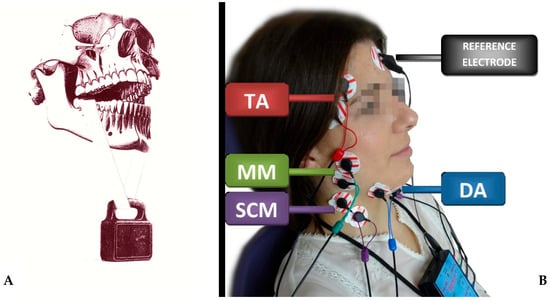You're using an outdated browser. Please upgrade to a modern browser for the best experience.
Please note this is a comparison between Version 1 by Grzegorz Zieliński and Version 3 by Rita Xu.
Surface electromyography (sEMG) is a technique for measuring and analyzing the electrical signals of muscle activity using electrodes placed on the skin’s surface.
- electromyography
- electrodiagnosis
- temporomandibular joint
- history of dentistry
1. Introduction
Surface electromyography (sEMG) is a technique for measuring (development and recording) and analyzing the electrical signals of muscle activity using electrodes placed on the skin’s surface [1][2][1,2]. sEMG works by detecting and analyzing electrical signals that result from physiological changes in the cell membranes of muscle fibers [1]. A key aspect of sEMG is the understanding that human tissue, particularly muscle, has the ability to generate and conduct electrical impulses that are fundamental to the process of muscle contraction [3]. When a muscle is at rest, it is in a state of electrical equilibrium known as the resting potential. However, during contraction, depolarization of the muscle membrane occurs, which means that there is a flow of ions between the inside and outside of the muscle membrane, generating an electrical signal that is recorded [1][4][5][1,4,5].
2. Surface Electromyography in Dentistry—History
2.1. The 17th Century
The concept of “animal spirits” has a rich history in the realm of physiology and psychology. It was a concept that worked for 1500 years (Figure 1) [6][38]. Originating in ancient times, it was initially proposed by Greek philosophers like Galen, who believed that these spirits were responsible for sensation and movement. During the Middle Ages, this idea was further developed by Islamic and European scholars, who postulated that animal spirits were fine, vaporous substances flowing through the body’s nerves and brain [7][39]. People have become increasingly familiar with human anatomy. In 1543, Andreas Vesalius created seven books under the title De Humani Corporis Fabrica Libri Septem on anatomy [8][40].
Figure 1. An artistic interpretation of the historical concept of ‘animal spirits’ in human physiology. Derived on 2 January 2024 by DALL-E 2 program (OpenAI, Inc., San Francisco, CA, United States).
-
1681. The earliest evidence of research into the strength of the masticatory muscles comes from the work of Giovanni Alfonso Borelli. He recorded a “biting force” of up to 200 kg (about 430 pounds) [12][13][26,27]. The test method used by Borelli consisted of placing a weight under the patient’s mandible [14][28].
2.2. The 18th Century
The 18th century was crucial for the development of electricity, marking a transformative period in its understanding and application. This era witnessed the birth of modern electrical science. These advancements paved the way for the electrical innovations of the 19th century, which revolutionized society.-
1745–1746. The origins of the development of modern electrophysiology can be traced back to the creation of an early condenser. The Leyden jar was invented independently by Dean von Kleist and Petrus van Musschenbroek. This device was used to collect and store electric charge and was one of the first discoveries in the field of electricity [15][16][34,44].
-
1746. Jean-Antoine Nollet conducted an experiment in which the test group consisted of about 200 monks who held hands to form a long chain over a kilometer long (Figure 2). At one end of the chain, Nollet used a Leyden jar to create an electric charge. When the charge was released, it passed through the entire chain of monks. Each of the monks felt a shock as the charge passed through their bodies. The monks’ reactions to the electric shock were instantaneous and simultaneous, demonstrating that electricity can be transmitted through the human body over great distances at tremendous speed. This was the first human study of electricity on such a scale [17][45].
-
1772. John Walsh’s research on electric fish, such as the electric eel (torpedo), proved that the shocks given off by these fish were a form of electricity. Using a Leyden jar, a device for storing electric charge, Walsh collected and measured electric discharges, providing direct evidence of the electrical nature of the shocks; his work was published in 1773 [20][21][48,49]. Walsh’s experiments probably contributed to Luigi Galvani’s decision to begin his experiments on frog muscle contraction [22][50]. However, Galvani’s experiments focused on a completely different aspect—the electricity generated by the muscles. Luigi Galvani’s discovery, which took place at the end of the 18th century, is often described as a series of coincidences and experimental observations.
-
1791. Luigi Galvani’s accidental experiment took place in 1791. Galvani was performing anatomical experiments on a frog in his laboratory. At the same time, some of his colleagues were playing with a Leyden jar. While Galvani was working, an electric spark was unexpectedly produced by the Leyden jar. At the exact moment the spark was emitted, Galvani touched the frog’s nerve with a metal knife. The result was a violent contraction of the frog’s muscles, which shocked and fascinated Galvani [15][34]. The results were published in 1791 [23][51].

Figure 2. An illustration of Jean-Antoine Nollet’s experiment. Derived on 13 January 2024 by DALL-E 2 program (OpenAI, Inc., San Francisco, CA, United States) (slightly corrected by the author G.Z.).
2.3. The 19th Century
In the 19th century, researchers inspired by the previous century continued to investigate electricity, nerve conduction and the study of the strength of the masticatory muscles.-
1803. Inspired by the work of his uncle Luigi Galvani, Giovanni Aldini was the first to demonstrate the reactions of the muscles of dead men to electrical stimulation from a battery of galvanic cells. His most famous experiment took place at the Royal College of Surgeons in London in 1803, on a hanged man called George Forster [24][52].
-
1825. Leopoldo Nobili built the astatic galvanometer [25][53]. An astatic galvanometer is a special type of galvanometer designed to minimize the influence of an external magnetic field on its readings. The main purpose of such a solution is to increase the sensitivity and accuracy of electric current measurements.
-
1838. Inspired by Luigi Galvani, Carlo Matteucci, in an 1838 study, observed the frog’s muscle responses to different types of electrical stimulation, which allowed him to understand the basic mechanisms of bioelectricity in living tissues. He used a complete frog leg, cut off below the knee, with only an isolated nerve above [15][34]. Carlo Matteucci used the astatic galvanometer invented by Leopoldo Nobili for his research [26][54]. This discovery was key to understanding the mechanisms by which nerve impulses cause muscle contractions [27][55].
-
1849. Emil du Bois-Reymond was inspired by the work of Carlo Matteucci. One of du Bois-Reymond’s most important achievements during this period was his demonstration that stimulation of a nerve causes an electrical change, which he called an ‘action potential’. This discovery was fundamental to understanding how nerve impulses transmit information in the body. He described it in 1849 in his work ‘Untersuchungen über thierische Elektricität’ [28][56]. Du Bois-Reymond also discovered that it was possible to record (using a galvanometer) electrical activity during voluntary muscle contraction [2]. In the same year, Hermann von Helmholtz measured at what speed a nerve signal is transmitted through the nerve fibers of a frog and reported transmission rates ranging from 24.6to 38.4 m per second [29][30][57,58].
-
1862. Guillaume Benjamin Duchenne conducted research into the transcutaneous electrical stimulation of muscles and was able to do so as early as 1833 [15][34]. However, it was not until 1862 that Duchenne published the work “Mécanisme de la Physionomie Humaine” [32][60] that he included the results of his research on facial expressions, which he carried out using electrical muscle stimulation, and also included the identification of motor points.
-
1868. Julius Bernstein, in his work from 1868, theorized that a living cell’s interior consists of an electrolytic substance and that the cell is separated from its surrounding environment by a membrane. This membrane is characterized by its limited permeability to ions. Consequently, he suggested that the cell membrane would be the primary resistive component within a cell [33][61].
-
1895. Greene Vardiman Black conducted a bite force study. He reported that in 1895, he tested the bite force of several thousand people and found that the average was 175 pounds [35][63]. Black achieved his results by designing a new gnathodynamometer. His device was used to measure intraoral forces caused by vertical jaw movements [36][64].
2.4. The 20th Century
The 20th century was critical for the development of surface electromyography. In this period, significant advancements were made in both the theoretical and practical aspects of sEMG. Early in the century, the foundational principles of muscle electricity were established, leading to the development of more sophisticated sEMG equipment. These advancements allowed for the non-invasive recording of muscle electrical activity, providing valuable insights into muscle physiology, movement disorders and rehabilitation. The technological advancements in electronics and computing during the latter half of the century enabled the more precise, real-time analysis of sEMG data, further enhancing its diagnostic and research capabilities. The integration of sEMG with other technologies, like biofeedback and computerized analysis systems, opened new avenues in medical research.-
1912. Hermann Piper was the first to describe the phenomenon known as the H-wave. The H-wave is the electrical response of a muscle to nerve stimulation. It is a form of reflex that can be recorded by electromyography and its measurement is used to assess peripheral nerve function and neuromuscular integration. Piper analyzed the electrical activity in the muscles in response to electrical stimulation of the ulnar nerve. He published his results in the paper ‘’Elektrophysiologie menschlicher muskeln” [38][66]. It is worth noting that Hermann Piper is considered to be the first scientist to study the surface electrical signal. This was the first study of surface electromyography. He did this using a string galvanometer [10][42].
-
1913–1915. Napoleon Cybulski suggested that the carrier of electricity in skeletal muscle could be ions flowing across the semi-permeable membrane in his work entitled “Prądy czynnościowe nerwów i ich stosunek do temperatur” and in a subsequent work of the same year entitled “Model prądów czynnościowych w mięśniach” [41][42][69,70]. In 1915, Napoleon Cybulski recorded the first electrical signal in mammalian (dogs and rabbits) muscle fibers [37][43][65,71].
-
1924. Hans Berger made the first recording of electroencephalography (EEG) in humans and introduced the name that is still used today. He also described the types of waves and rhythms present in a properly functioning brain. This influenced the development of the EMG, sEMG and paved the way for research into human bioelectricity [47][75].
-
1925. E. K. Liddell and Charles Sherrington made significant contributions to theour understanding of motor units in muscle physiology. They conducted experiments on the flexor muscles in the cat’s knee, providing crucial insights into how motor units function. Their work helped to establish the concept of the motor unit, defining it as a single motor neuron and the group of muscle fibers it innervates. This research was fundamental in understanding muscle contraction and the role of the nervous system in controlling muscle movement [49][77].
-
1937. Joseph Erlanger and Herbert Spencer Gasser published the paper entitled “Electrical Signs of Nervous Activity” [52][80]. In this work, Gasser and Erlanger described in detail their findings regarding the conduction velocity of nerve impulses and the various properties of nerve fibers. Using a cathode-ray oscilloscope, they were able to accurately record and analyze the electrical signals generated by nerves. Their research contributed to a deeper understanding of the mechanisms of nerve conduction and had a major impact on the development of neurology and electrophysiology.
-
1938. Edmund Jacobson realized that there was a deep connection between muscle tension and emotional state. He conducted numerous experiments using surface electromyography to monitor muscle tension in people in different situations. Through these studies he proved that stress, anxiety and negative emotions lead to an increase in muscle tension. His most important paper was published in 1938—“Progressive Relaxation” [53][81].
-
1941. Kenneth S. Cole and Robert H. Cole published a research paper “Dispersion and Absorption in Dielectrics I. Alternating Current Characteristics” that delves into the behavior of dielectrics (insulating materials) when subjected to alternating current. It primarily explores how these materials disperse and absorb electrical energy, focusing on their alternating current (AC) characteristics. This study is foundational in understanding the dielectric properties of materials, which has implications in various fields of electrical and materials engineering [56][83].
-
1944. V. T. Inman, J B Saunders and L. C. Abbott analyzed the superficial electromyography of shoulder movements [58][85]. In the same year, Joseph Erlanger and Herbert Spencer Gasser won the Nobel Prize in Physiology or Medicine “for their discoveries relating to the highly differentiated functions of single nerve fibers” [59][86].
-
1947. Edward Lambert established the first electromyography laboratory in the United States and the first EMG training program. His research began in 1948 and focused on the use of EMG in the diagnosis of myasthenia gravis. Lambert is often referred to as the “father of electromyography” [60][87]. His early research established EMG as a fundamental neurological tool.
-
1952. Alan Lloyd Hodgkin and Andrew Fielding Huxley published five papers describing a series of experiments and an action potential model [10][42]. Amongst others, entitled “A Quantitative Description of Membrane Current and its Application to Conduction and Excitation in Nerve”. This work describes in detail how changes in the conductance of sodium and potassium ions across the cell membrane of an axon affect the generation and conduction of an action potentials [66][90]. Among others, they published another paper entitled: “Currents Carried by Sodium and Potassium Ions through the Membrane of the Giant Axon of Loligo”. This work focused on the study of ionic currents flowing through the membrane of the axon and their role in nerve conduction [67][91]. Published mainly in the 1950s, it was of great importance to neurophysiology, and its results are still fundamental to understanding the electrical activity of neurons. The Hodgkin–Huxley model is still used today in modern neuroscience research and mathematical models of neuronal activity.
-
1954. Fritz Buchthal published a paper entitled: “Action potential parameters in normal human muscle and their physiological determinants” [70][94]. This work had a significant impact on the development of electromyography as a diagnostic tool in medicine. Buchthal is therefore considered one of the pioneers of clinical electromyography [43][71].
-
1965. The International Society of Electrophysiological Kinesiology was founded as an international organization. During the International Congress of Anatomy in the Rhein-Maine-Halle, Wiesbaden, Germany in the summer of 1965, a group of anatomists convened to discuss the formation of a small society dedicated to electrophysiological kinesiology. Among those present were notable individuals like J.V. Basmajian, S. Carlsøø, B. Jonsson, M.A. MacConaill, J. Pauly and L. Scheving [76][99].
-
1966. Moller published a paper entitled: “The chewing apparatus: An electromyographic study of the action of the muscles of mastication and its correlation to facial morphology”. It was one of the first papers of its kind on the action of the masticatory muscles and its correlation to facial morphology [78][101].
-
1968. Herman P. Schwan published a paper entitled: ‘’Electrode Polarization Impedance And Measurements In Biological Materials” [79][102]. It appeared in the Annals of the New York Academy of Sciences. This study is significant in the field of bioimpedance, particularly focusing on the challenges and methodologies related to measuring the electrical properties of biological materials.
-
1978. G. J. Pruim, J. J. Ten Bosch and H. J. de Jongh published a paper entitled: ‘’Jaw muscle EMG-activity and static loading of the mandible” [85][108]. The study outlines a method for correlating EMG activity in jaw muscles with static biting forces. It supports the linear relationship between integrated EMG activity and force produced by muscles in isometric conditions. It also notes distinct functional behaviors in the anterior and posterior parts of the temporal muscle. The study emphasizes the significant role of opening muscles as antagonists, suggesting their importance should not be overlooked in muscle force analysis [85][108].
-
1980. M. Bakke and E. Møller conducted a study entitled ‘’Distortion of maximal elevator activity by unilateral premature tooth contact” [87][110]. On the basis of this, they note that a one-sided premature contact resulted in a notable imbalance of action across all the muscles being examined, showing increased activity on the side of the contact. As the thickness of the overlay was enhanced, there was a corresponding decrease in the mean voltage on both sides. This asymmetry is thought to be due to heightened spindle afferent activity on the side of the contact compared to the opposite side. Furthermore, the overall decrease in muscle activity is attributed to a progressive reduction in activity stemming from the periodontal pressure receptors [87][110].
-
1986. A. Sheikholeslam, K. Holmgren, and C. Riise suggested that using an occlusal splint can alleviate or reduce the signs and symptoms of functional disorders. It can also normalize and lessen the postural activity in the temporal and masseter muscles. This improvement may aid in procedures like functional analysis and occlusal adjustment by establishing more balanced muscle activity [94][117].
-
1991. The group of V.F. Ferrario, C. Sforza, A. D’addona, A. Miani Jr., using the BIO-PAK system (Bio-Research Associates Inc., Milwaukee, WI, USA), stated that the electromyographic system and protocol used allowed good reproducibility of measurements in chewing muscle testing. The authors stated that electromyographic testing has potential applications in clinical and research settings [98][121].

Figure 3. The difference of 340 years of research on masticatory muscles between the discoveries of Giovanni Alfonso Borelli and modern sEMG studies (8-channel BioEMG III electromyography, BioResearch Associates, Inc., Milwaukee, WI, USA). (A) shows the assumptions of the 1681 Giovanni Alfonso Borelli study and (B) the 2021 study. TA—the temporalis anterior muscle; MM—the superficial part of the masseter muscle; DA—the anterior belly of the digastric muscle; SCM—the middle part of the sternocleidomastoid muscle. The elements for graphic A were generated on 2.01.2024 using the DALL-E 2 program (OpenAI, Inc., San Francisco, CA, USA), and merged by the author G.Z.
